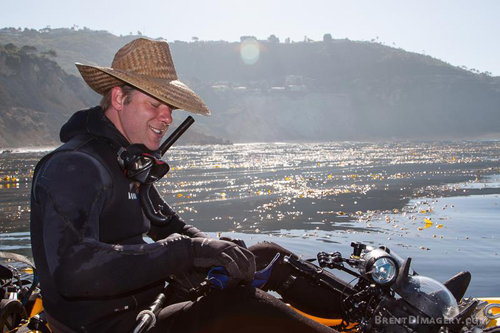 |
Felimare sechurana
Image courtesy of Yuri HookerSend Yuri email at yuhooker@gmail.com
Laboratorio de Biologia Marina, Facultad de Ciencias y Filosofia
Universidad Peruana Cayetano Heredia,Av.Honorio Delgado 430,Urb.Ingenieria,S.M.P.,Lima,Peru
It seems that we have another species of Felimare in the Eastern Pacific! Felimare sechurana (Hoover et al, 2017) is found in the southeastern Pacific Ocean along the coast of Peru. Molecular evidence indicates that it is a close relative of F. californiensis, found in the northeastern Pacific in Southern California and Baja. We hypothesize that the two species came from an ancestral population that dispersed across the tropical eastern Pacific during the Pleistocene, when ice sheets covered much of the continents. During this period of Earth's history larvae of warm-temperate sea slugs may have been able to disperse across the tropical eastern Pacific Ocean. Such dispersal likely represents a sweepstakes route. Molecular evidence indicates that F. californiensis in the northeastern Pacific and F. sechurana southeastern Pacific have been isolated for approximately 1 - 2 million years.
Another conclusion of Hoover et al (2017) is that F. ghiselini is a synonym of F. californiensis. It is curious to note that there is a latitudinal gradient in the morphology of F. californiensis, but these differences do not seem to correlate to genetic differences. Such evidence indicates that ecology may affect the morphology of Felimare. Just because slugs look unique, that doesn't mean they are different species!
Although Hoover et al (2017) brings us one step closer to understanding the biodiversity and evolutionary history of the genus Felimare in the eastern Pacific, we are still a long way from the full picture. For example, the molecular relationship between F. lapislazuli found at the Galapagos Islands and F. sechurana along the coast of Peru is unknown. Also, preliminary photographic evidence indicates the possibility of yet another species of Felimare from the tropical eastern Pacific, possibly related to F. agassizi.
Anyway, I'm sure we'll hear more about these little blue critters in the coming years!
Craig Hoover
Reference:
Integrative taxonomy of the Felimare californiensis and F. ghiselini species complex (Nudibranchia: Chromodorididae), with description of a new species from Peru
Craig A Hoover, Vinicius Padula Michael, Schrodl, Yuri Hooker, Angel Valdes
Journal of Molluscan Studies, Volume 83, Issue 4, 1 November 2017, Pages 461-475,
Department of Biological Sciences
California State Polytechnic University
3801 W Temple Ave.,Pomona,CA 91768,USA
Oct., 2017
Send Craig email at crghvr@yahoo.com
Craig Hoover on location
 |
Hi fellow branchers. My name is Craig Hoover. I am I am a biologist with interest in the biodiversity, ecology, and evolution of communities. I specialize in nudibranchs of the eastern Pacific Ocean, and would like the opportunity to study in the eastern Atlantic one of these days. Hasta la proxima! Send Craig email at crghvr@yahoo.com |

|
